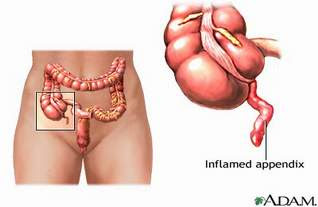Definition of Meningitis
Meningitis is inflammation of the meninges (the membranes that surround the brain and spinal cord) and is caused by a virus, bacteria or fungus organs (Smeltzer, 2001).
Meningitis is an infection of the fluid of the brain with inflammatory piamater, arachnoid and in a milder degree of the brain and spinal cord tissues were superficial. (Neurology capita selekta, 1996)
Meningitis is an inflammation of the arachnoid and pia mater (lepto meningens) of the brain and spinal cord. Bacteria and viruses are the most common cause of meningitis, although fungi can also cause. Bacterial meningitis is more common. Early detection and treatment will give more better results according to Revelation Widagdo et al (2008:105)
Etiology of Meningitis
Meningitis caused by a virus is generally harmless, will recover without specific treatment and care. But bacterial meningitis can lead to serious conditions, such as brain damage, hearing loss, lack of ability to learn, can even cause death. While meningitis is caused by a fungus is very rare, this type generally affects people with damaged immune (immune system) as in patients with AIDS.
Bacteria that can cause meningitis attack include:
1. Streptococcus pneumoniae (pneumococcus).
These bacteria are the most common cause of meningitis in infants or children. This type of bacteria can also cause pneumonia, ear and nasal cavity (sinus).
2. Neisseria meningitidis (meningococcus).
This bacterium is the second most after Streptococcus pneumoniae meningitis caused by an infection of the upper respiratory tract and then the bacteria enter the bloodstream.
3. Haemophilus influenzae (Haemophilus).
Haemophilus influenzae type b (Hib) is a type of bacteria that can also cause meningitis. This type of virus as the cause upper respiratory infections, middle ear and sinuses. Vaccine (Hib vaccine) has shown a decrease in the number of cases of meningitis caused by these bacteria.
4. Listeria monocytogenes (listeria).
This is one type of bacteria that can cause meningitis. These bacteria can be found in many places, in the dust and in contaminated food. Food is usually a type of cheese, hot dogs and bacon sandwich which is derived from the bacterium local animal (pet).
5. Other bacteria that can also cause meningitis are Staphylococcus aureus and Mycobacterium tuberculosis.
Clinical Manifestations of Meningitis
Meningitis is inflammation of the meninges (the membranes that surround the brain and spinal cord) and is caused by a virus, bacteria or fungus organs (Smeltzer, 2001).
Meningitis is an infection of the fluid of the brain with inflammatory piamater, arachnoid and in a milder degree of the brain and spinal cord tissues were superficial. (Neurology capita selekta, 1996)
Meningitis is an inflammation of the arachnoid and pia mater (lepto meningens) of the brain and spinal cord. Bacteria and viruses are the most common cause of meningitis, although fungi can also cause. Bacterial meningitis is more common. Early detection and treatment will give more better results according to Revelation Widagdo et al (2008:105)
Etiology of Meningitis
Meningitis caused by a virus is generally harmless, will recover without specific treatment and care. But bacterial meningitis can lead to serious conditions, such as brain damage, hearing loss, lack of ability to learn, can even cause death. While meningitis is caused by a fungus is very rare, this type generally affects people with damaged immune (immune system) as in patients with AIDS.
Bacteria that can cause meningitis attack include:
1. Streptococcus pneumoniae (pneumococcus).
These bacteria are the most common cause of meningitis in infants or children. This type of bacteria can also cause pneumonia, ear and nasal cavity (sinus).
2. Neisseria meningitidis (meningococcus).
This bacterium is the second most after Streptococcus pneumoniae meningitis caused by an infection of the upper respiratory tract and then the bacteria enter the bloodstream.
3. Haemophilus influenzae (Haemophilus).
Haemophilus influenzae type b (Hib) is a type of bacteria that can also cause meningitis. This type of virus as the cause upper respiratory infections, middle ear and sinuses. Vaccine (Hib vaccine) has shown a decrease in the number of cases of meningitis caused by these bacteria.
4. Listeria monocytogenes (listeria).
This is one type of bacteria that can cause meningitis. These bacteria can be found in many places, in the dust and in contaminated food. Food is usually a type of cheese, hot dogs and bacon sandwich which is derived from the bacterium local animal (pet).
5. Other bacteria that can also cause meningitis are Staphylococcus aureus and Mycobacterium tuberculosis.
Clinical Manifestations of Meningitis
- Early in the disease, fatigue, changes in power to remember, change in behavior
- In accordance with the rapid course of the disease the patient becomes stuporous
- Headache
- Sore muscle pain
- Pupillary reaction to light. Photofobia when light is directed at the patient's eye.
- Dysfunction of the nerves III, IV, VI
- Motor movement at the beginning of the disease is usually normal and common in the advanced stages of hemiparesis, hemiplagia, and decreased muscle tone
- Reflex positive Brudzinski and Kernig reflex
- Nausea
- Vomiting
- Tachycardia
- Convulsions
- Patients feel fear and anxiety
































